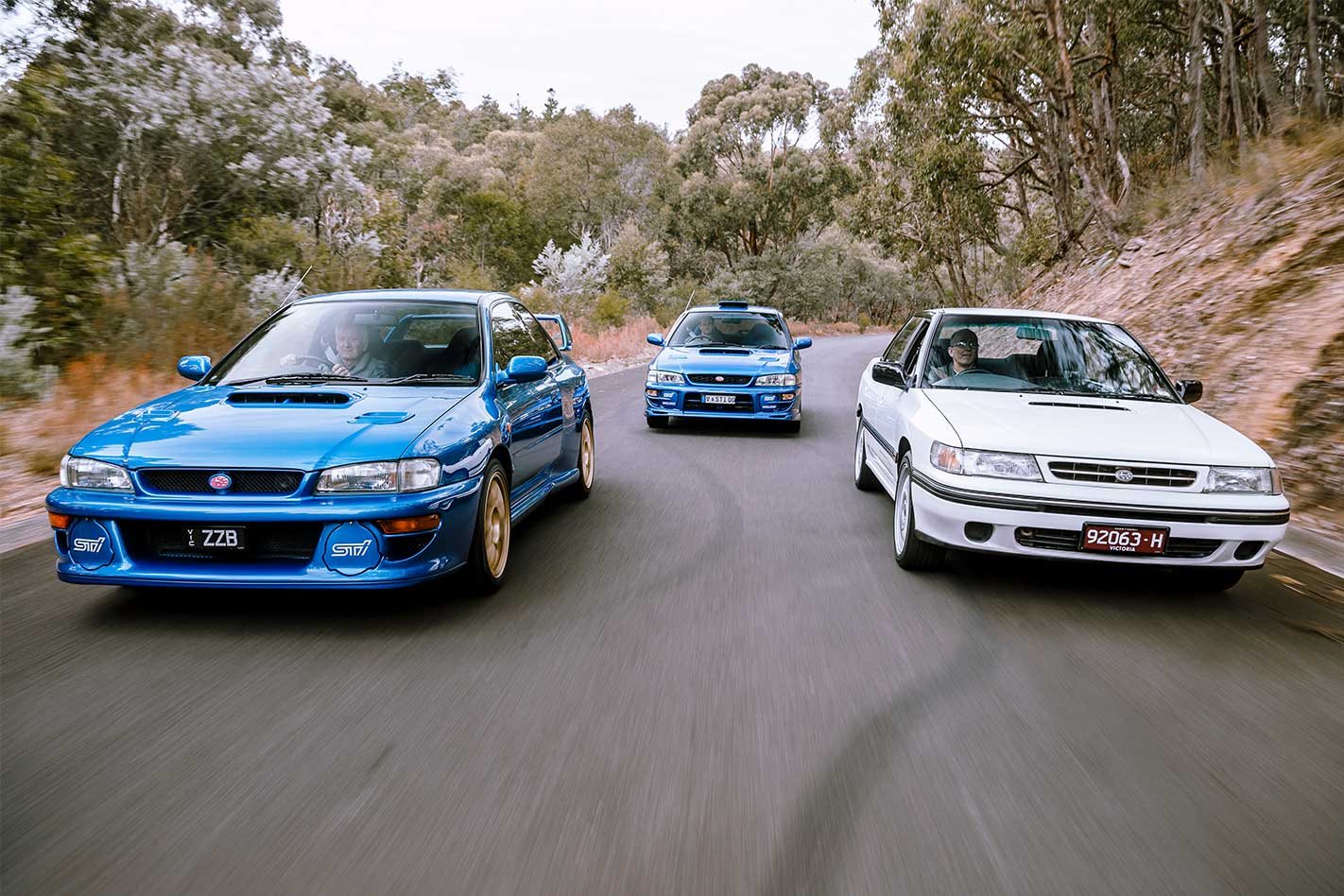Making anything work for you for three decades is never going to be easy (ask Mrs M). And the motor industry is no different.
Oh sure, you could crank out four-wheeled cannon-fodder for the same period of time without much trouble, but to actually stay right at the front of the development and engineering curve for that length of time is a major win.
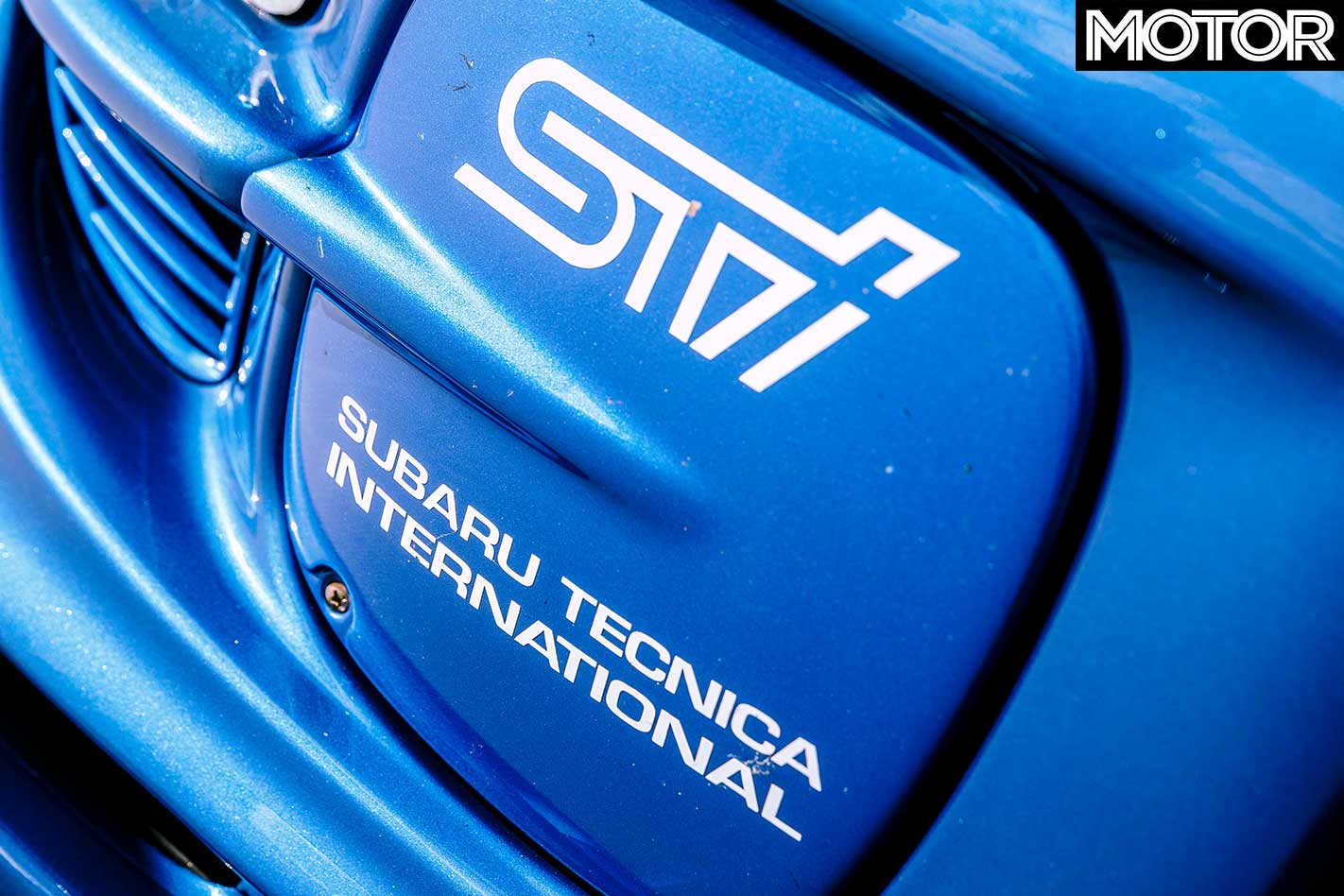
Thanks to multiple WRC victories, a handful of world championships and even record-breaking runs, we tend to think of STi as the birthplace of Subaru’s competition aspirations.
Actually, it wasn’t and the first time a works-backed Suby turned a wheel in timed anger was, in fact, right here in Australia when the factory entered a Leone (remember them?) in the 1972 Southern Cross Rally. But Subaru could see the sense in having a dedicated race shop which could be used to spin off exciting, profitable road cars for the masses, so in 1988, STi was established.
This concept, in itself, was not exactly rocket science; Subaru would have been watching the activities of other performance divisions including AMG and BMW’s M (and maybe even HSV) and could see that a stand-alone operation was a beaut way to build a brand image and some street cred.
These days, anybody with any hope of separating punters from a little bit more of their hard-earned money has a performance arm, but back in 1988 it was still a big leap for a conservative Japanese operation.
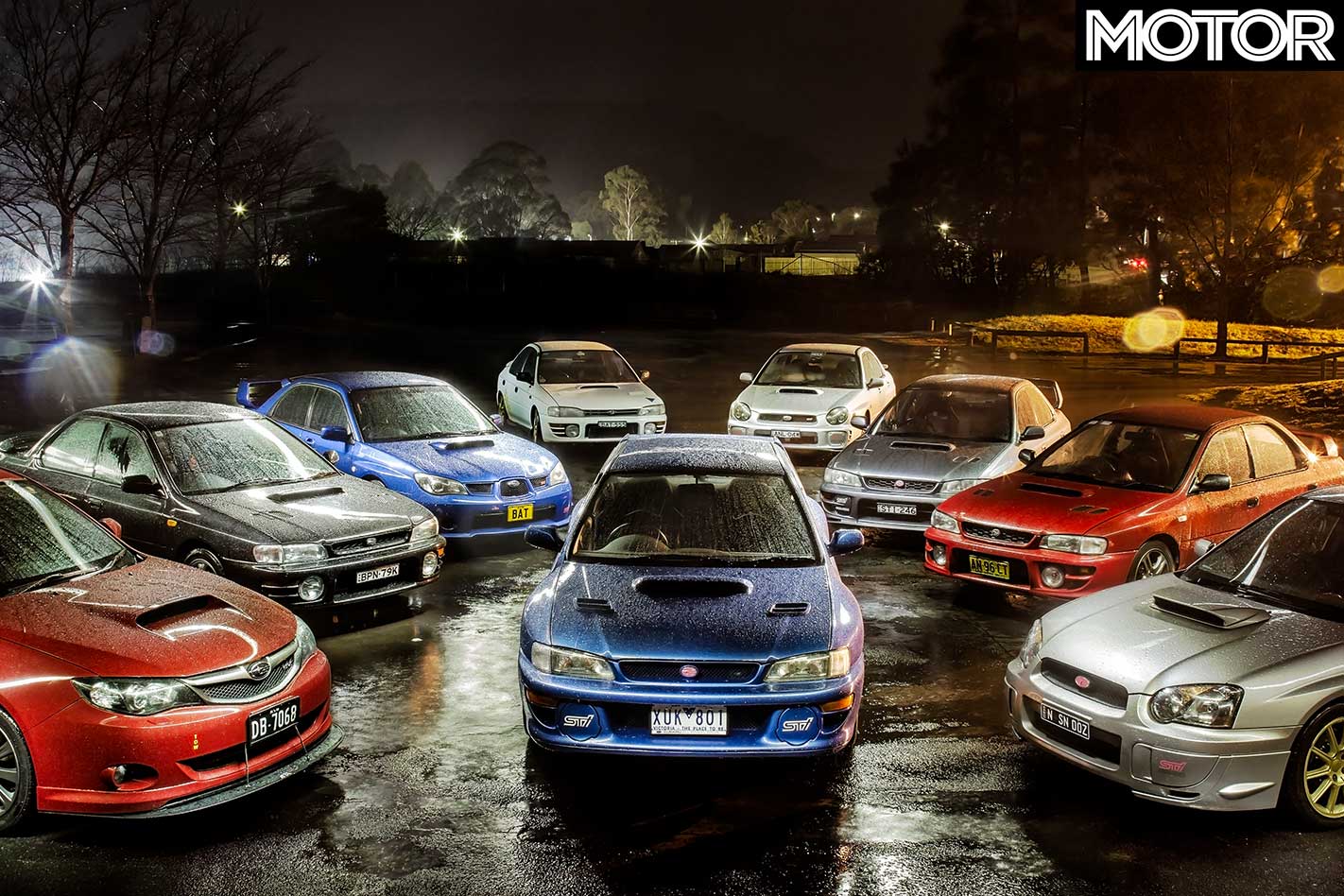
Which is not to say the other major Japanese factories hadn’t worked out the same for themselves, and by the time STi hit the headlines, Toyota had been operating its TRD outfit since 1976, Mitsubishi established Ralliart in 1983 and Nismo had been a force in motorsport since its establishment in 1984. But even though it was a while coming, it’s probably the STi franchise that has had the best cut-through in Australia.
That’s largely because Subaru has been good enough to give we antipodeans a fair suck of the sauce bottle. While the best and brightest models from the other Japanese car-makers often didn’t make it down here (you don’t think Peter Williamson’s class-winning 1981 Bathurst Celica was the fastest thing across the mountain with the Corona engine from Aussie-spec Celicas, do you?) Subaru has tried its best to give us lot and not just a small taste of a rich crop.
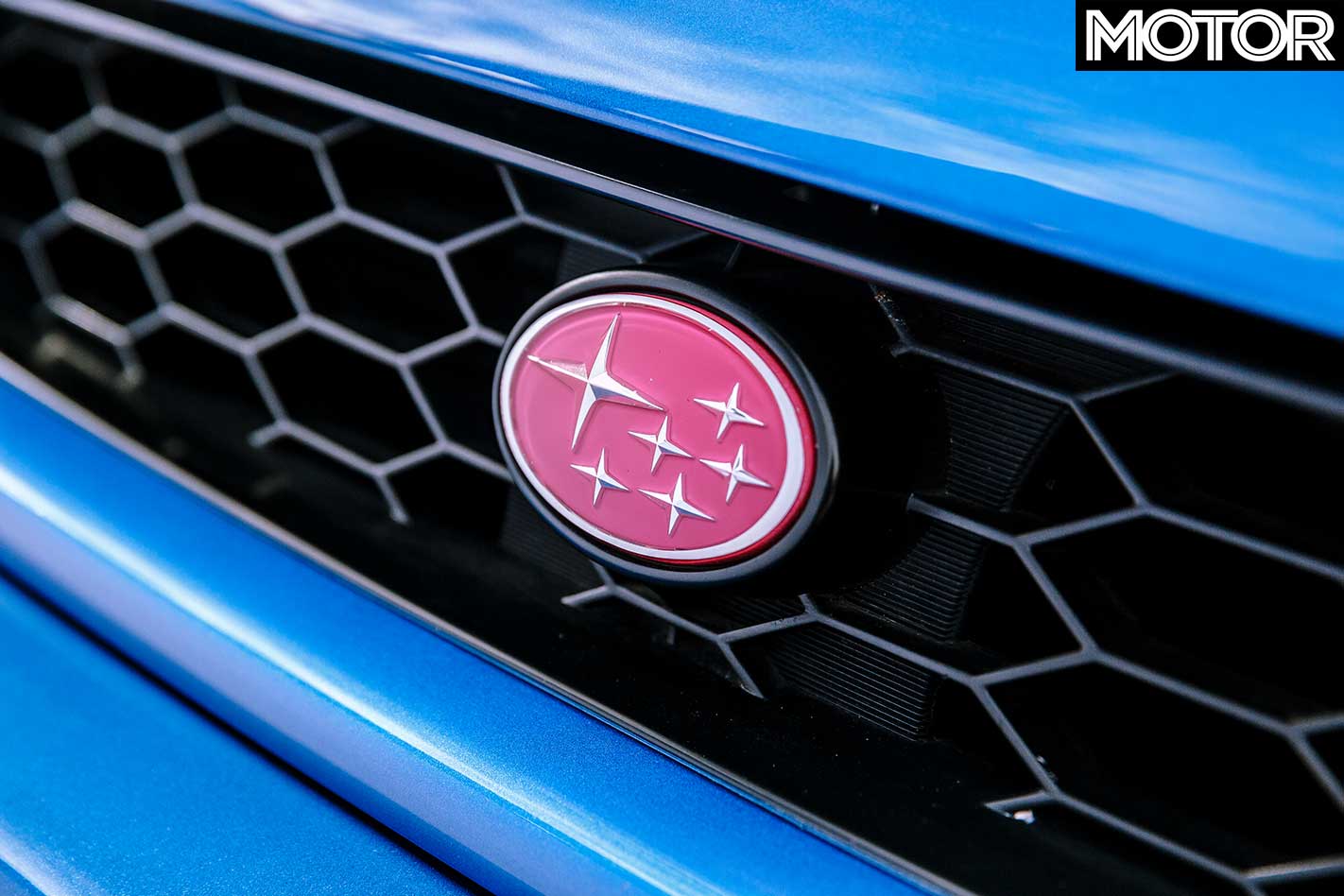
No, we haven’t been privy to all of STi’s hits, but by the same token, there isn’t a rev-head kid who doesn’t know what a WRX STi represents.
So for us at MOTOR, the idea of celebrating three decades of tear-arse Subies was a no-brainer. And the trio we’ve picked out to sample are absolutely representative of the type of lateral thinking that is a central part of the magic of any performance car. Oh, and we got to drive them.
1990 Subaru Legacy RS RA The genesis for forest-fighting, go-fast Subarus
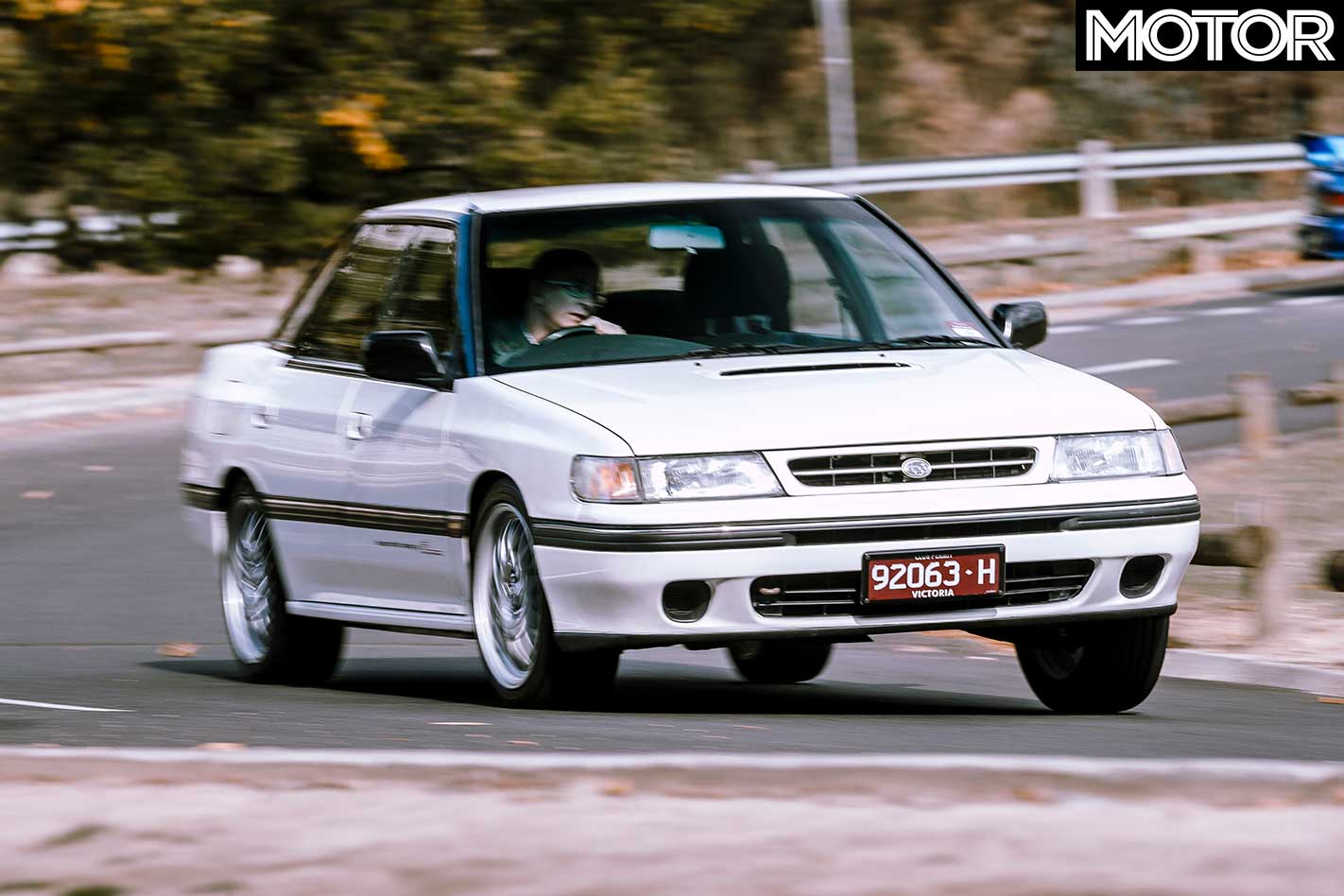
Just as a Walkinshaw VL will always be the seminal HSV and that crazy, 6.8-litre 300 SEL racecar is revered as the first AMG, so too does the Legacy RS RA represent a line in the sand. As STi’s first full model, the RA is the grand-daddy of them all.
While the Legacy (and Liberty out here) RS was a cult hit back in the day, the real wonder was reserved for the RA model. But the way the model came about is a bit left field. See, while STi was founded to create halo cars for the Subaru brand and to homologate cars that could win rallies at the highest level, the RA was kind of a celebration of a publicity stunt conducted by STi in the very early days.
Back in 1989, STi took four specially prepared Legacies and, with the FIA watching, ran them on an oval track in Arizona for 18 long days, racking up 100,000km in the process and topping out at almost 225km/h. In the process, the cars set a new world speed endurance record and STi was on the map. And this car, the RA (which stands for Record Attempt) was the production-based fruit of all that.

But don’t go thinking it’s an RS with an STi decal. Oh no. As well as putting the Legacy on a diet with less sound-deadening, thinner glass and a sunroof-delete deal, the RA also got a much tougher engine and driveline. That started with forged pistons, hand-ported cylinder heads, stronger rods and a full balance of all the reciprocating bits.
Power was the same claimed 161kW (or 162, depending on who you talk to) and, combined with a 1290kg kerb weight, the RA was a proper statement back in 1990 when it hit showrooms.
STi continued to fiddle with the concept for the next few years adding, among other things, a close-ratio five-speed gearbox. However, the aim always was to keep the RA a low-volume model. Which is why it only built 100 cars in 1990, 286 in ’91, 217 in ’92 and just ’93 in 1993. And this white car is one of that last batch.
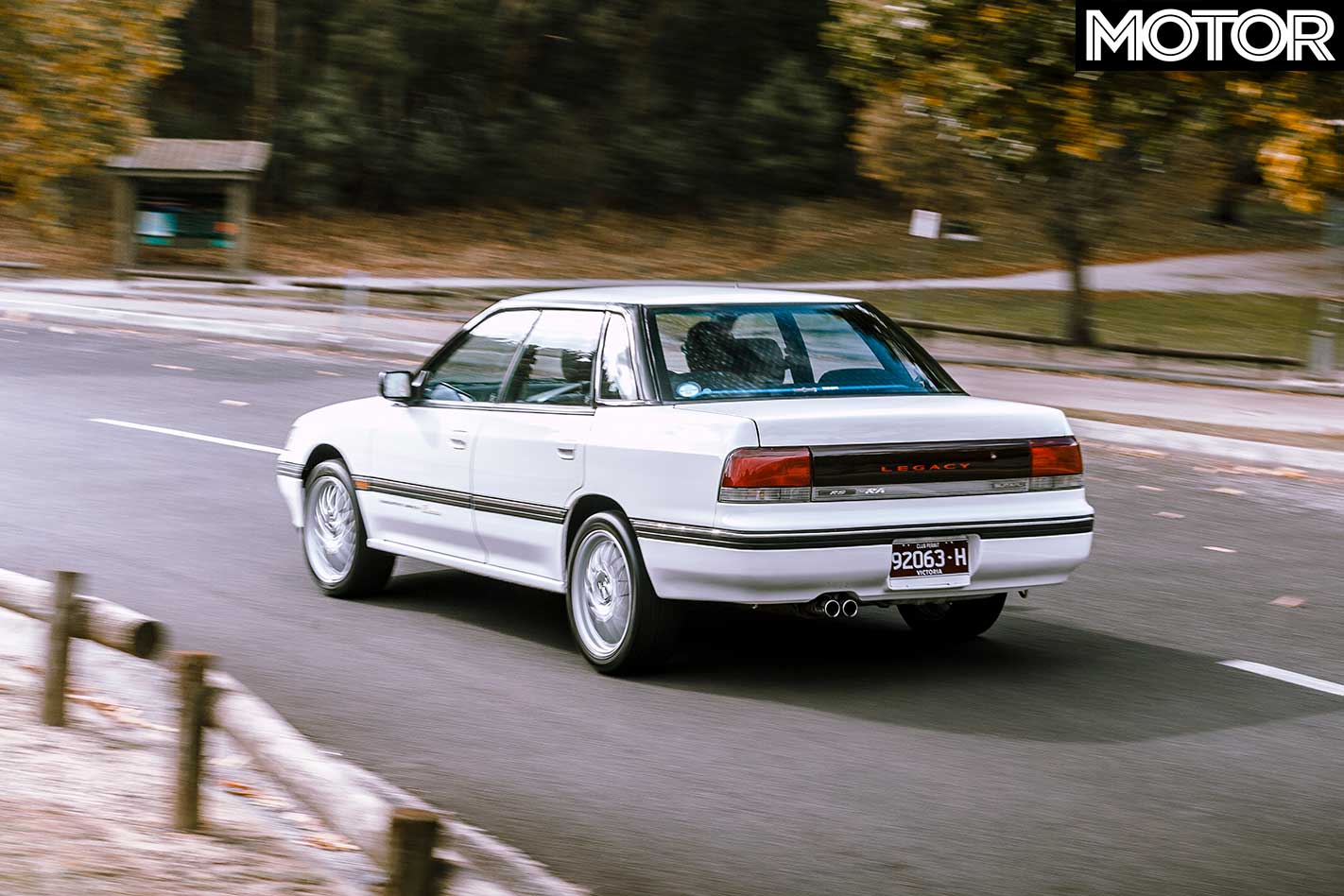
Once a rampaging, high-tech special, the RA these days seems a bit milder. Then again, the visual approach taken by STi back in the day was pretty subtle. But the truth is that it’s more of a cruiser these days than a red-hot poker. But, lord, does it take me back. That skinny Momo wheels is absolutely gorgeous and the way the whole interior looks, feels and smells propels me straight back to the late ’80s.
The balanced bottom end makes itself felt right from the off, too, and there’s a lot less of that Subaru thrumminess through the gears than I recall. It gets along, too, and while there’s no doubt it’ll spin hard, it’s also torquey and flexible enough to be short-shifted and still provide enough clarity of shunt to be effective.
The close-ratio ’box has a straight-cut first and second, the former of which, in particular, makes a racket and tends to try to trip you up if you start shifting back to first before the car has stopped.

There’s a real fluidity to the way the RA gets down the road that I don’t recall in bread-and-butter Liberties and, despite some pretty munted dampers on this car, the RA feels light on its feet and a pretty vice-free platform. Okay, the performance probably wouldn’t trouble a modern Ford Fiesta ST but, just like a Walkinshaw or Red Sow, that’s hardly the point any more.
So why haven’t you seen more of them? Because they’re a dead-set Tassie Tiger. There’s reckoned to be two doing the rounds as rally cars and one road car. This one.
Meanwhile in the forest…
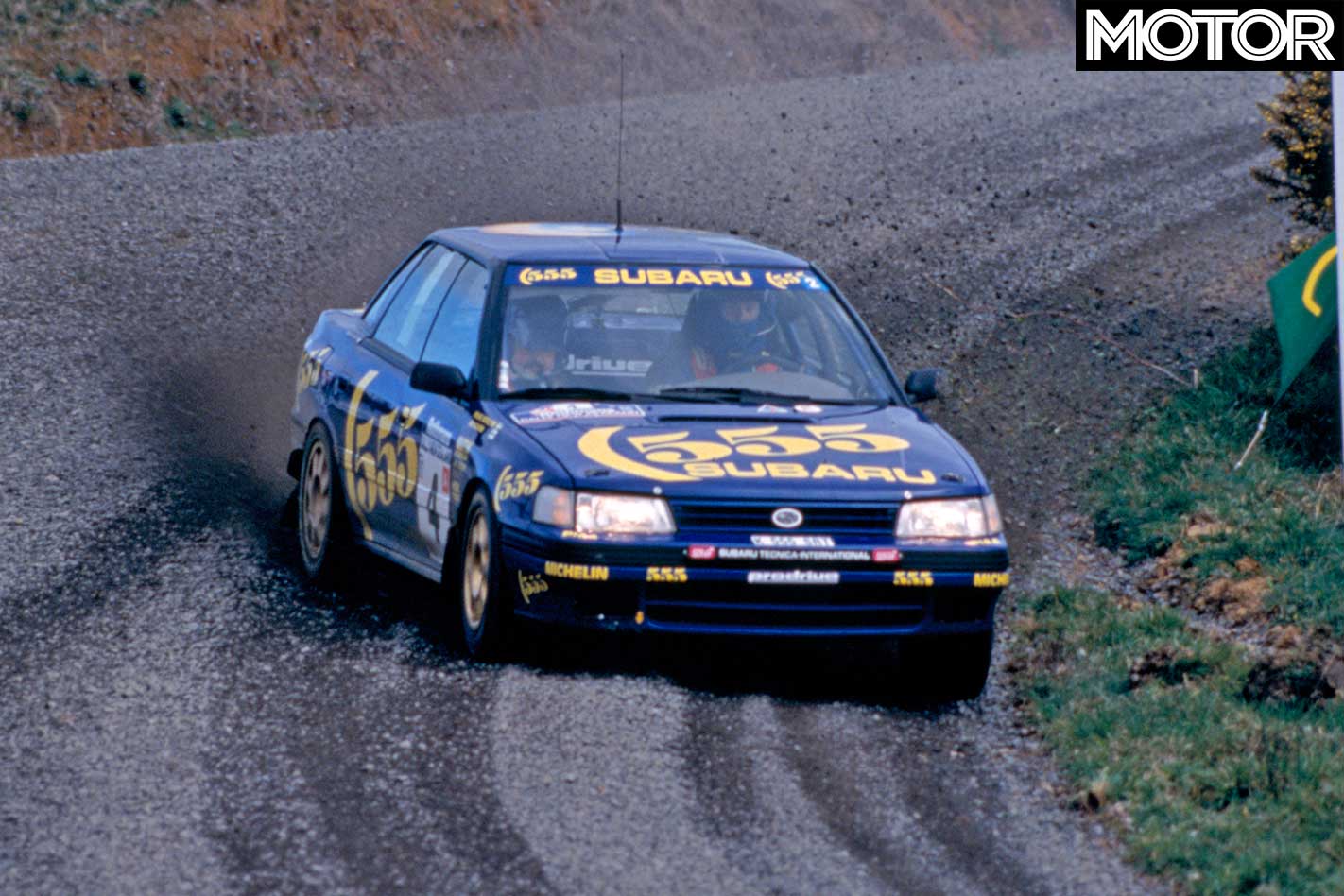
TIME was running out. Subaru was keen to introduce its new Impreza Group A car to the WRC, but not until the outgoing Legacy secured a win. Fittingly, its young Scottish charger, Colin McRae, delivered the goods.
Victory in New Zealand allowed the Legacy to bow out on top and the Impreza to make its planned debut in Finland, where it secured a fine second place.
FAST FACTS 1990 Subaru Legacy RS RA
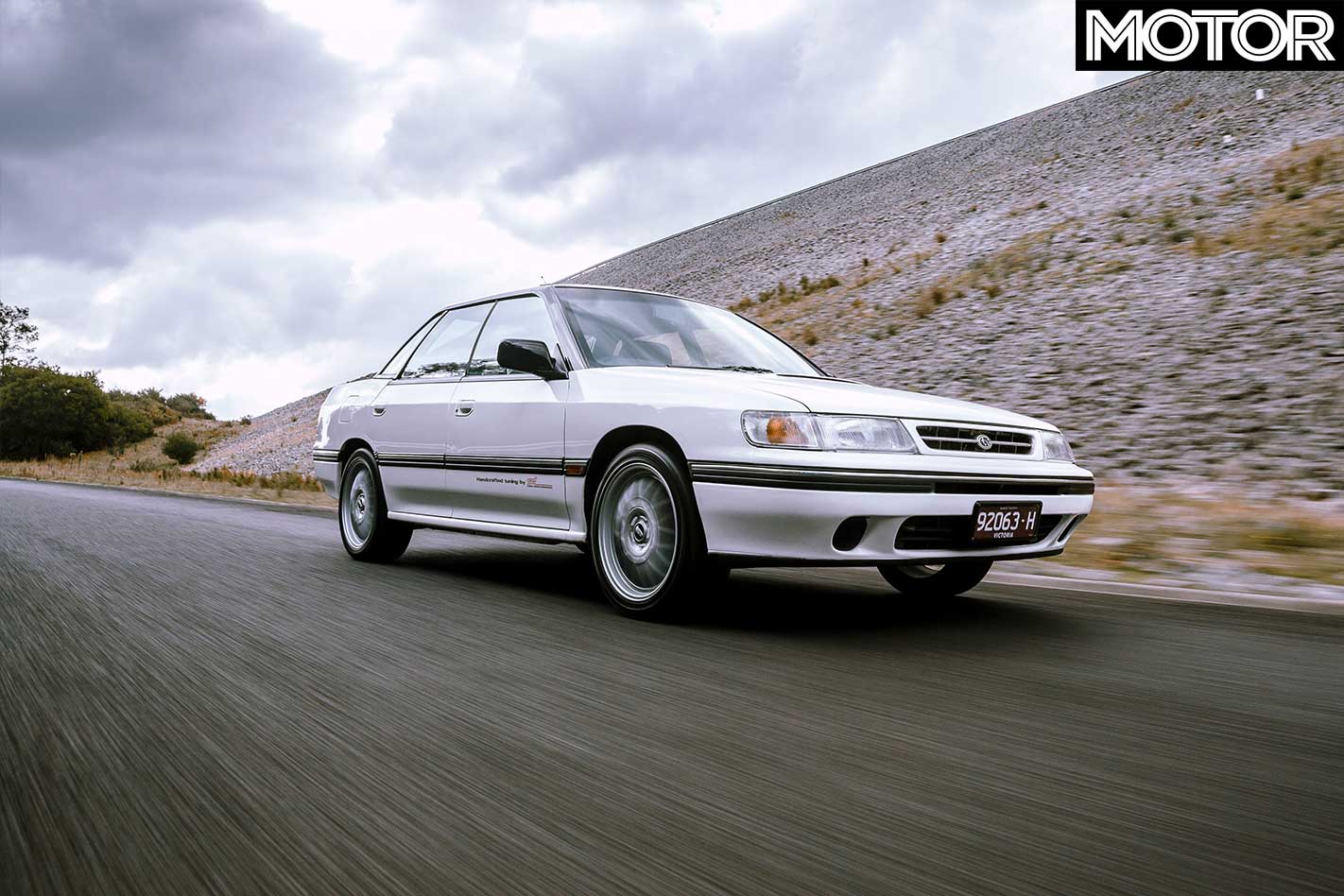
BODY: 4-door, 5-seat sedan DRIVE: all-wheel ENGINE: 1994cc flat-4, DOHC, 16v, turbo BORE/STROKE: 92.0mm x 75.0mm COMPRESSION: 8.5:1 POWER: 162kW @ 6400rpm TORQUE: 270Nm @ 4000rpm WEIGHT: 1290kg POWER-TO-WEIGHT: 126kW/tonne TRANSMISSION: 5-speed manual SUSPENSION: struts, coil springs, anti-roll bar (f); struts, coil springs, anti-roll bar (r) L/W/h: 4510/1690/1395mm WHEELBASE: 2580mm TRACKS: 1465/1455mm (f/r) STEERING: hydraulically-assisted rack-and-pinion BRAKES: ventilated discs (f); solid discs (r) WHEELS: 15.0 x 6.0-inch (f/r) TYRES: Yokohama; 255/60 R15 (f/r) PRICE: grey import only
2000 Subaru Impreza WRX STi Type R Souped-up two door is far more than the sum of its limited-edition parts
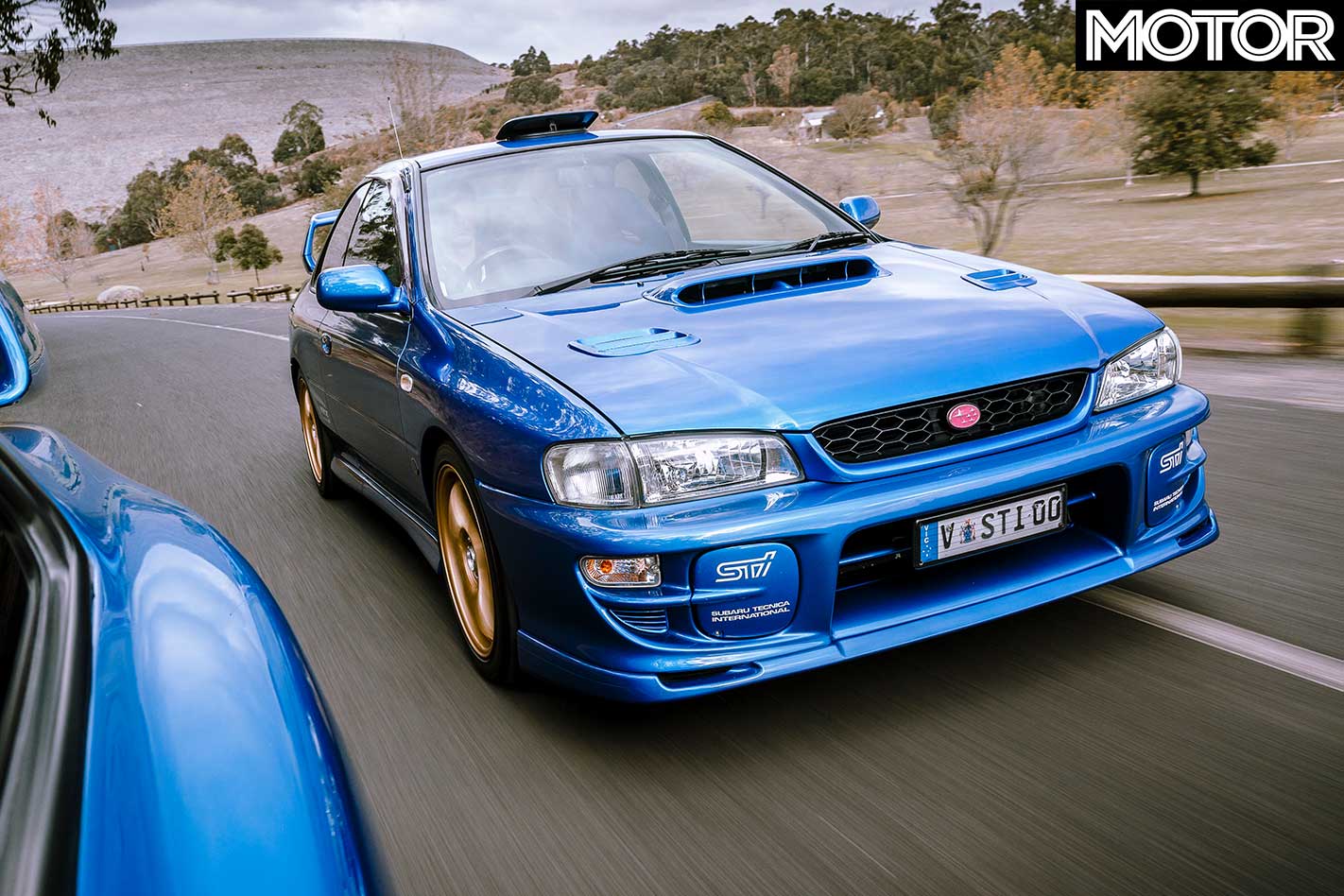
We all know the story of Subaru Australia importing a batch of 400 first-gen STis and promising there’d be no more. What it meant, of course, was that there’d be no more two-door STis because the batch of 400 four-doors was almost already on the water. Cue outraged two-door buyers.
But what Subaru Oz couldn’t get its hand on was this car, the Type R which was a souped-up version of the STi. This particular car is a Version 6, bears an MY00 build-date and is one of just 1000 examples worldwide.
Over a ‘standard’ STi, the Type R got the roof vent, the active (DCCD in Suby-speak) centre diff (which Australian-delivered STis wouldn’t see until 2005) a bigger turbocharger, shorter gearing, a quicker steering ratio, no sound deadening and a weighbridge ticket of just 1260kg. Combine that with the 206kW that was the mandated limit by the Japanese authorities (and was starting to be sniggered at) and you were talking a serious weapon at the turn of the century. Still is, in fact.
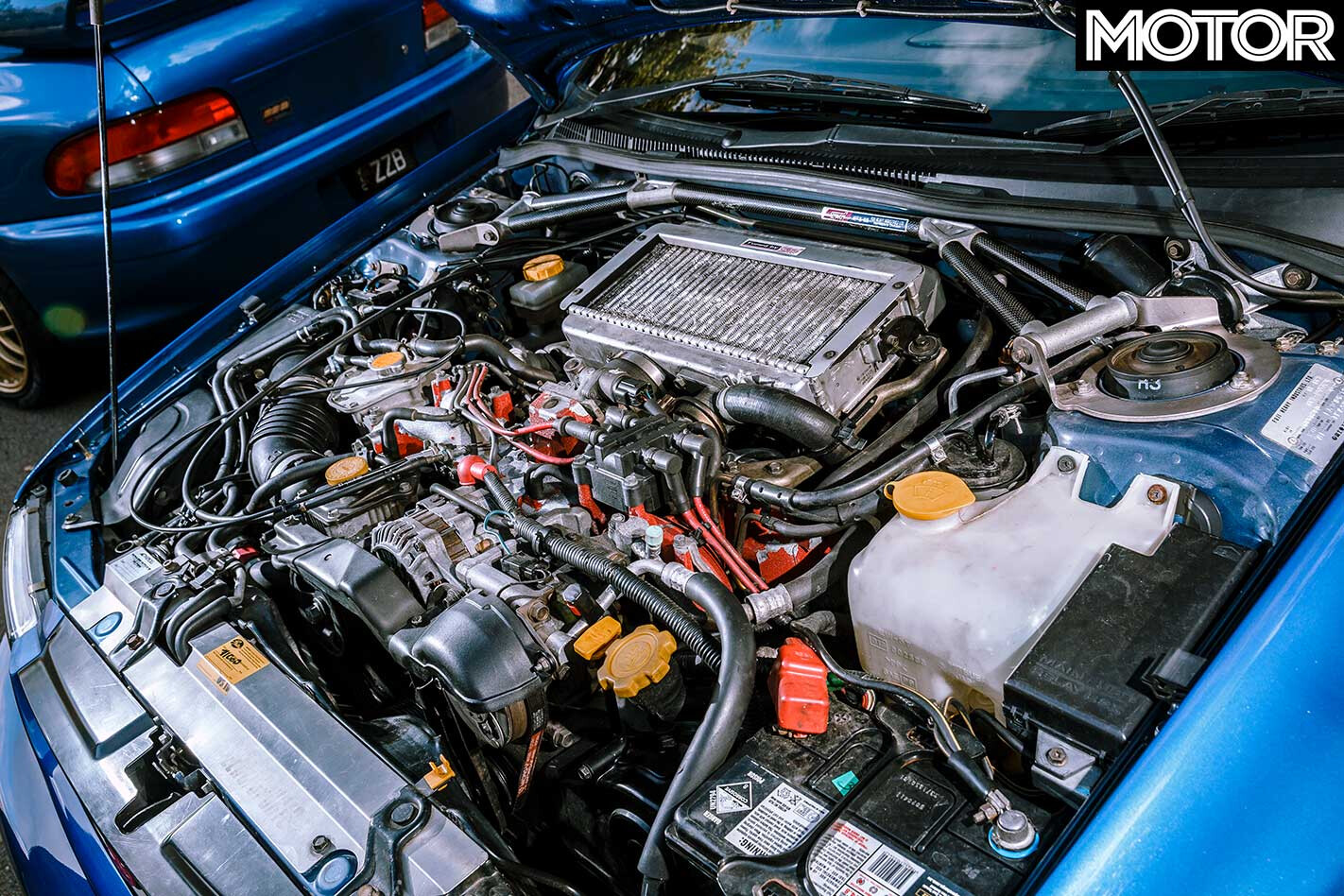
This car is one of maybe three or four in the country and they’re all, obviously, grey imports. If you’re anything like me, the first-gen WRX is the one. To my way of thinking, this – the very last of that series and very probably the most capable version outside of a 22B – is beyond merely desirable. Had the owner not been such a nice bloke, I’d probably have disappeared in the Type R and never returned.
And I’ll tell you something else for free – the cops would have needed to send their bravest and best (and fastest) to run me to justice, because this thing absolutely flies. And I don’t mean in a period sense. As in, right here, right now.
Even though it might have a bit more grip, I doubt that even the current-model STi would see which way this blue bomber went. And another thing: how come the current car leaves you pissing blood after a speed hump when this car, built almost two decades earlier, rides so much better?
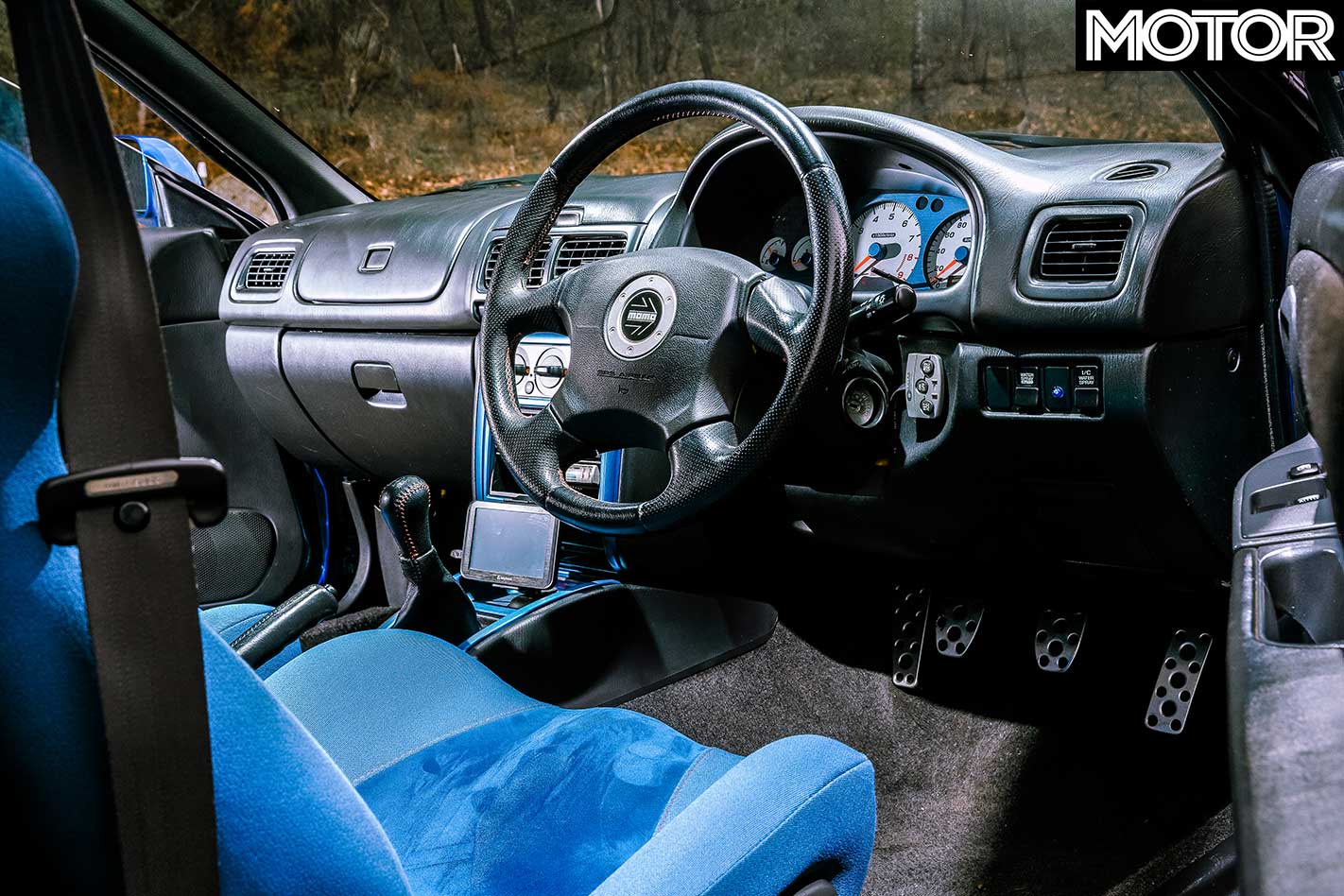
It’s not just a layer of plush that you weren’t expecting, it’s the whole way the type R deals with crappy roads without ever feeling mushy through the helm or the seats. Speaking of the seats, they’re just lovely and while they look a bit flat and shapeless, they’re anything but. And if ever you needed proof that lightness is a cornerstone of good car design, the featherweight Type R provides it.
It appears that, like the Legacy RA, Subaru managed to engineer all the nasty out of the STi in Type R form. The clutch is light and positive, the gearshift as close to idiot-proof as a H-patternmanual will ever be and even though the exhaust is a bit rowdier, it doesn’t drone at cruising speeds, nor is it likely to have Plod looking up from his donuts.
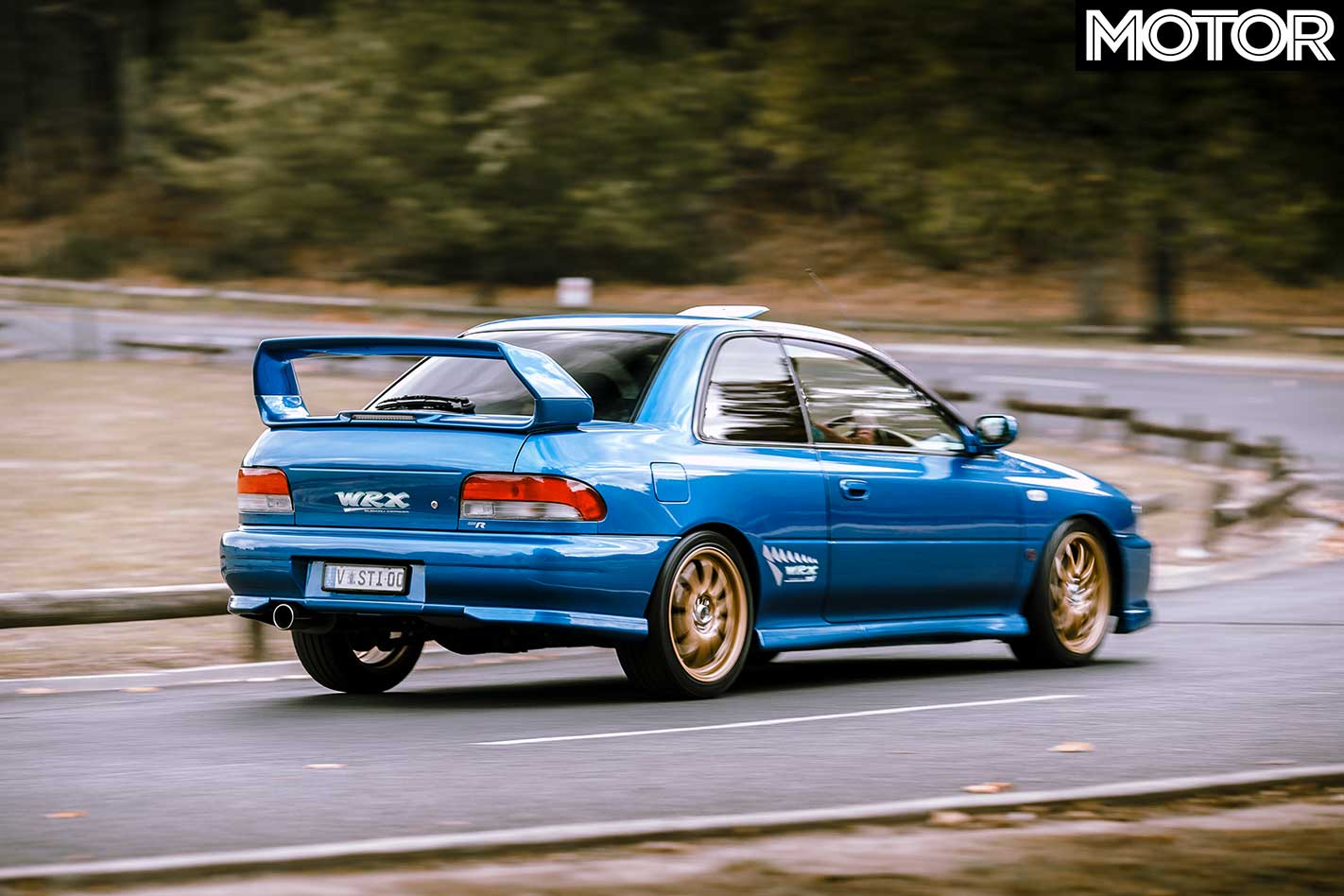
And then, while you’re still marvelling at the civility of it, you go and step on the noise pedal. And the Type R takes off. There’s very little lag and the short gearing (that sees about 3000rpm at 100km/h) ensures the thing always has a head of steam up.
Throw in the faster steering which is as neutral and natural as any Subaru I’ve ever driven, the high grip levels and the overall togetherness of the package and the Type R emerges as much, much more than just another hyped limited edition.
Meanwhile on the gravel…

COLIN McRae’s star had been in the ascendency for some time. His flamboyant, on-the-limit driving had frustrated his bosses and delighted fans, but it all came together when victory on the 1995 Rally GB secured his and Subaru’s first world motorsport title.
Despite many more victories, it would be McRae’s only title, finishing second in 1996, 1997 and 2001.
FAST FACTS 2000 Subaru Impreza WRX STi Type R
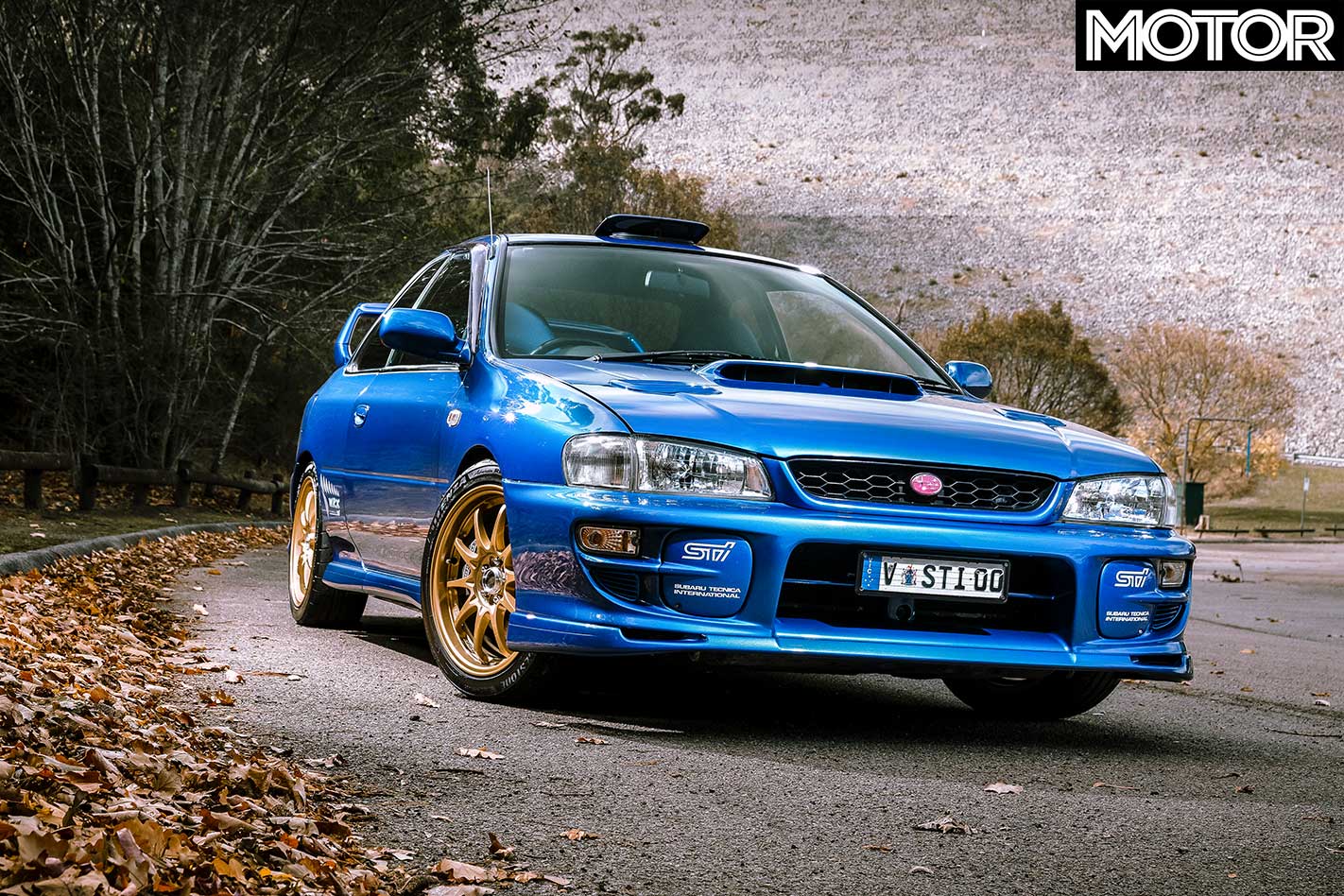
BODY: 2-door, 5-seat coupe DRIVE: all-wheel ENGINE: 1994cc flat-4, DOHC, 16v, turbo BORE/STROKE: 92.0mm x 75.0mm COMPRESSION: 8.0:1 POWER: 206kW @ 6500rpm TORQUE: 353Nm @ 4000rpm WEIGHT: 1240kg POWER-TO-WEIGHT: 166kW/tonne TRANSMISSION: 5-speed manual SUSPENSION: struts, coil springs, anti-roll bar (f); struts, coil springs, anti-roll bar (r) L/W/h: 4350/1690/1405mm WHEELBASE: 2520mm TRACKS: 1470/1460mm (f/r) STEERING: hydraulically-assisted rack-and-pinion BRAKES: 320mm ventilated discs (f); 266mm ventilated discs (r) WHEELS: 16 x 7.0-inch (f/r) TYRES: Yokohama; 205/50 R16 (f/r) PRICE: grey import only
1998 Subaru Impreza WRX STi 22B The ultimate STi – a performance watermark so high that modern Subarus are still yet to surpass it
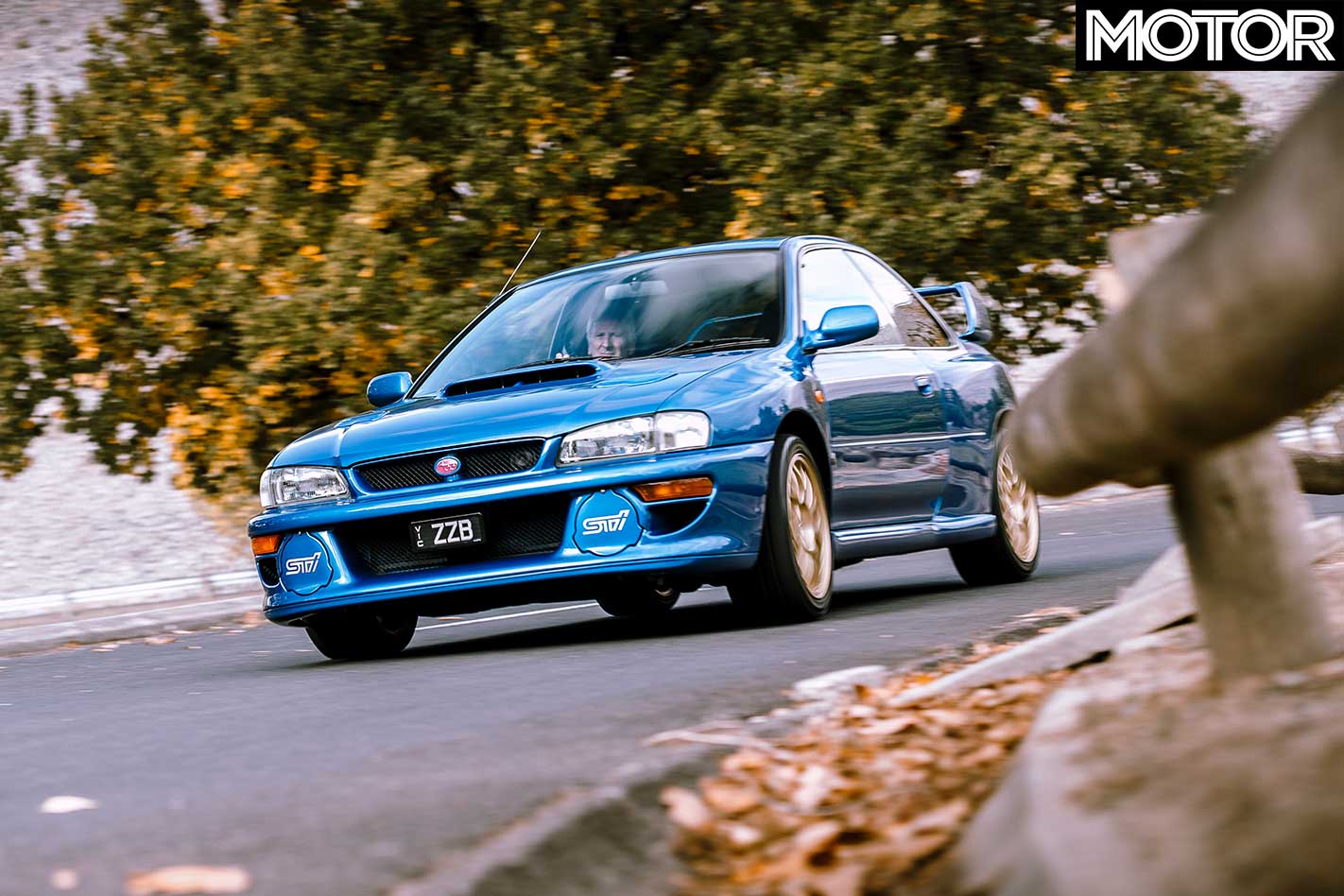
They had me at ‘22B’. Seriously, as a bloke who road-tested the very first WRXs and then STis in the day, the thought of coming face to face with an honest-to-god 22B was giving me the metaphorical dribbles.
While the 22B was a proper kitchen-sink effort, it wasn’t built to satisfy any arcane homologation requirements. Nope, it was a celebration car – making note of the fact that, in 1998, Subaru had just won three world championships on the trot.
To mark that occasion, STi took a two-door Rex and grafted on big, fat boxed guards front and rear. With some carefully considered offset on the 17-inch alloys, it stretched the front track by 60mm and the rear by 100mm. To say this thing looks tough is an understatement and, particularly from the rear, it’s all muscle and a warning to others.
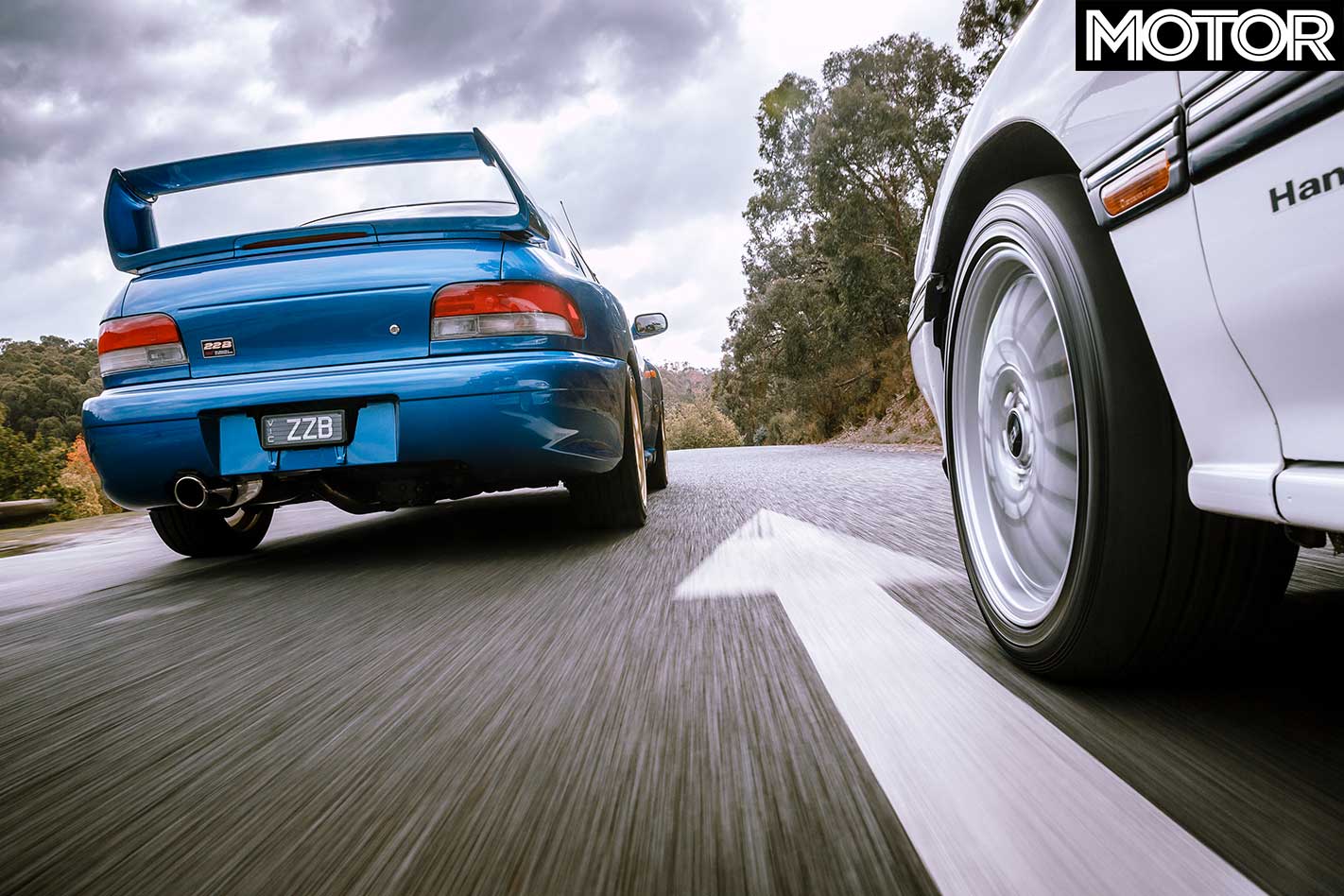
The 2.0-litre engine was hogged out to 2.2 (hence 22B), but there’s a lot more to it than that. In fact, the block itself is different with a closed-deck design for rigidity. With more careful matching of port sizes, camshafts, compression ratio and turbocharger, the EJ22 makes the same nominal (and under reported) 206kW, yet it manages an 8000rpm redline.
Although similar in spec to a Version 4 STi including the active centre-diff, the 22 also featured a seam-welded bodyshell as proof of how serious STi was. Chuck in an adjustable rear wing, a water spray for the top-mount intercooler and pull a bunch of weight out of it with a ban on sound deadening (and even deleting the spotlights) and you had a 22B.
Take it as read that this grey import drives like a new 22B. But even that doesn’t convey how remarkable this thing really is. Before you’re even out of the car park, it’s obvious that despite the stiff body, the 22B isn’t going to rattle your brains.
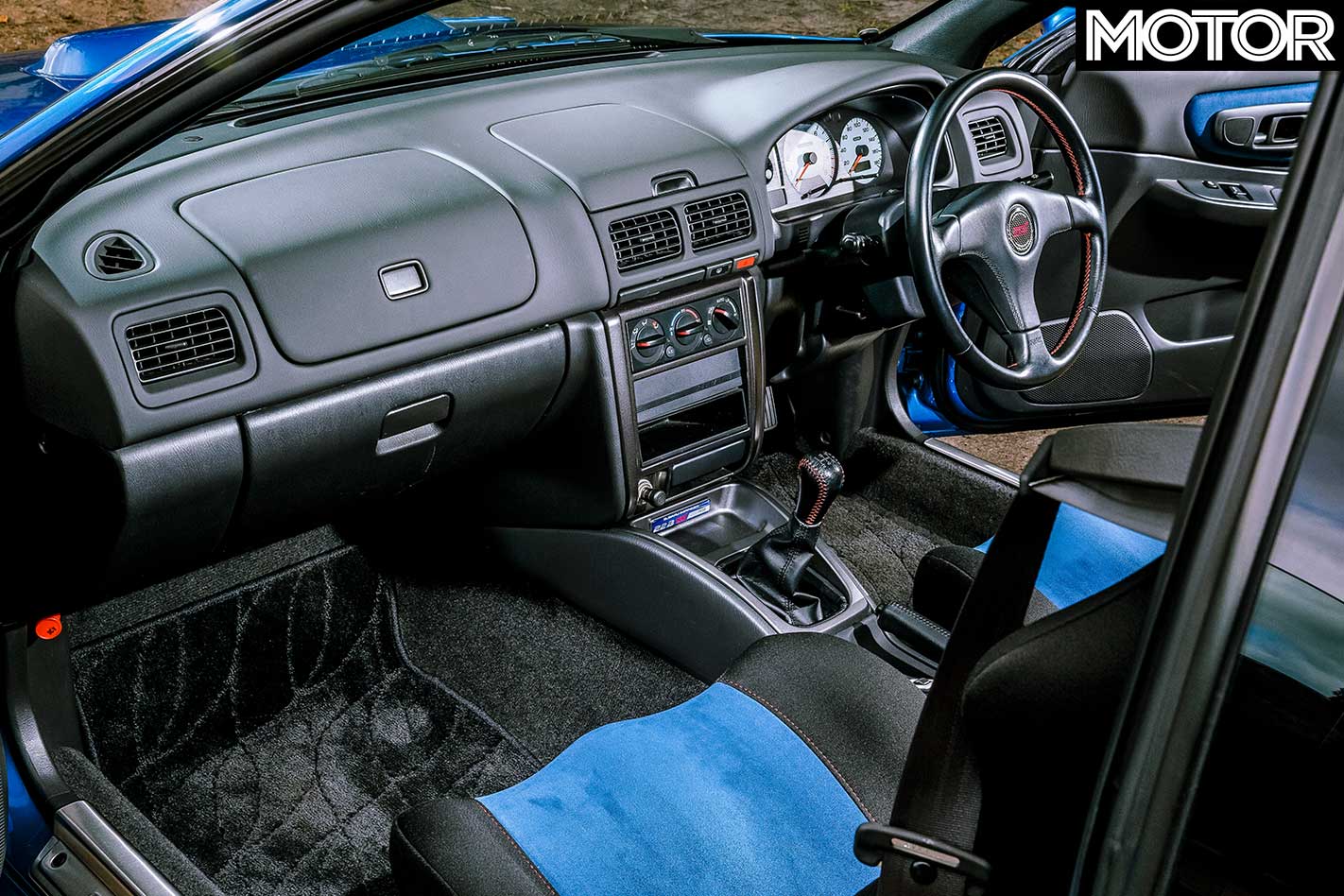
In fact, the ride is crazy good and, again, makes us question the current STi’s concrete-mattress impersonation. But the steering is equally friendly and the whole show is ballerina-light on its toes, but never feels nervous. Like the Type R, the 22B is a stark reminder of just how devastating excess weight is to dynamics and balance.
Then there’s the engine. Now, I know modern turbocharged engines are good, but I’ll put it out there and say that none of them are any better than this one, and most of them aren’t as good.
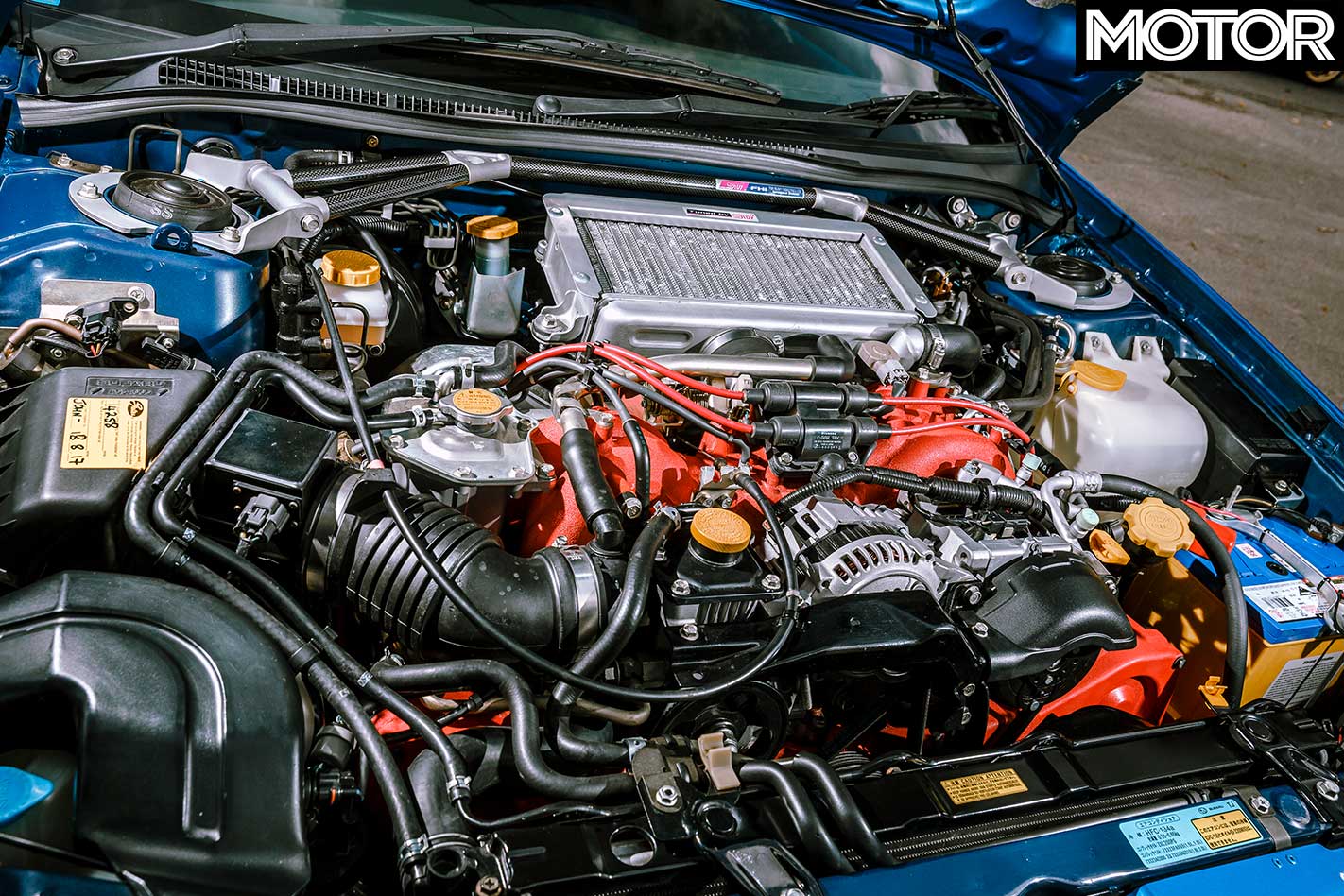
The mid-range is enormous, the low kerb mass and short gearing disguises any lag (if, indeed, there is any) and there’s a fabulous exhaust note that is a million miles removed from the chaff-cutter persona of a normal Rex with a drainpipe zorst. The pedal placement is perfect, the Momo is a scalpel and only a slight buzz from the gearshift tells you the car has done any kilometres at all.
When Subaru announced the 22B in 1998, the 424 cars slated for production sold out in 12 hours. Despite a sticker of $132,000 in Australia, four or five cars did actually make it here while 400 were for Japan and the rest went to the UK. Two of which wound up in the hands of none other than Colin McRae and his co-driver Nicky Grist as a thank you. Nice.
Meanwhile out on stage…
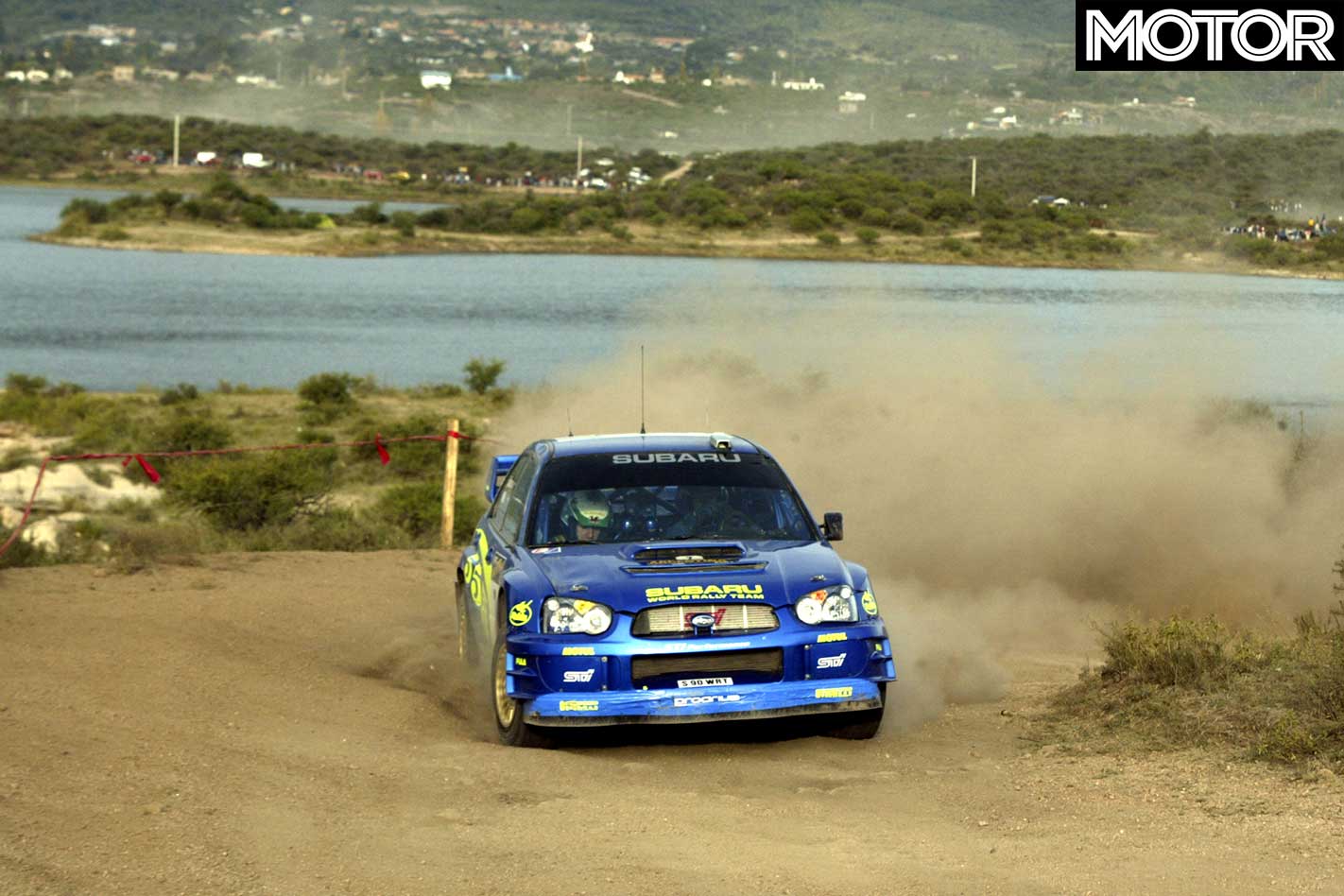
THE late-1990s and early-2000s was a golden period for Subaru. Between 1994-2004 it was by far the WRC’s most successful manufacturer with 43 wins, three manufacturers’ titles and three drivers’ titles for McRae (’95), Richard Burns (’01) and Petter Solberg (’03). Indeed, Subaru only recorded four WRC wins outside this period, pulling out of the sport at the end of 2008.
FAST FACTS 1998 Subaru Impreza WRX STi 22B
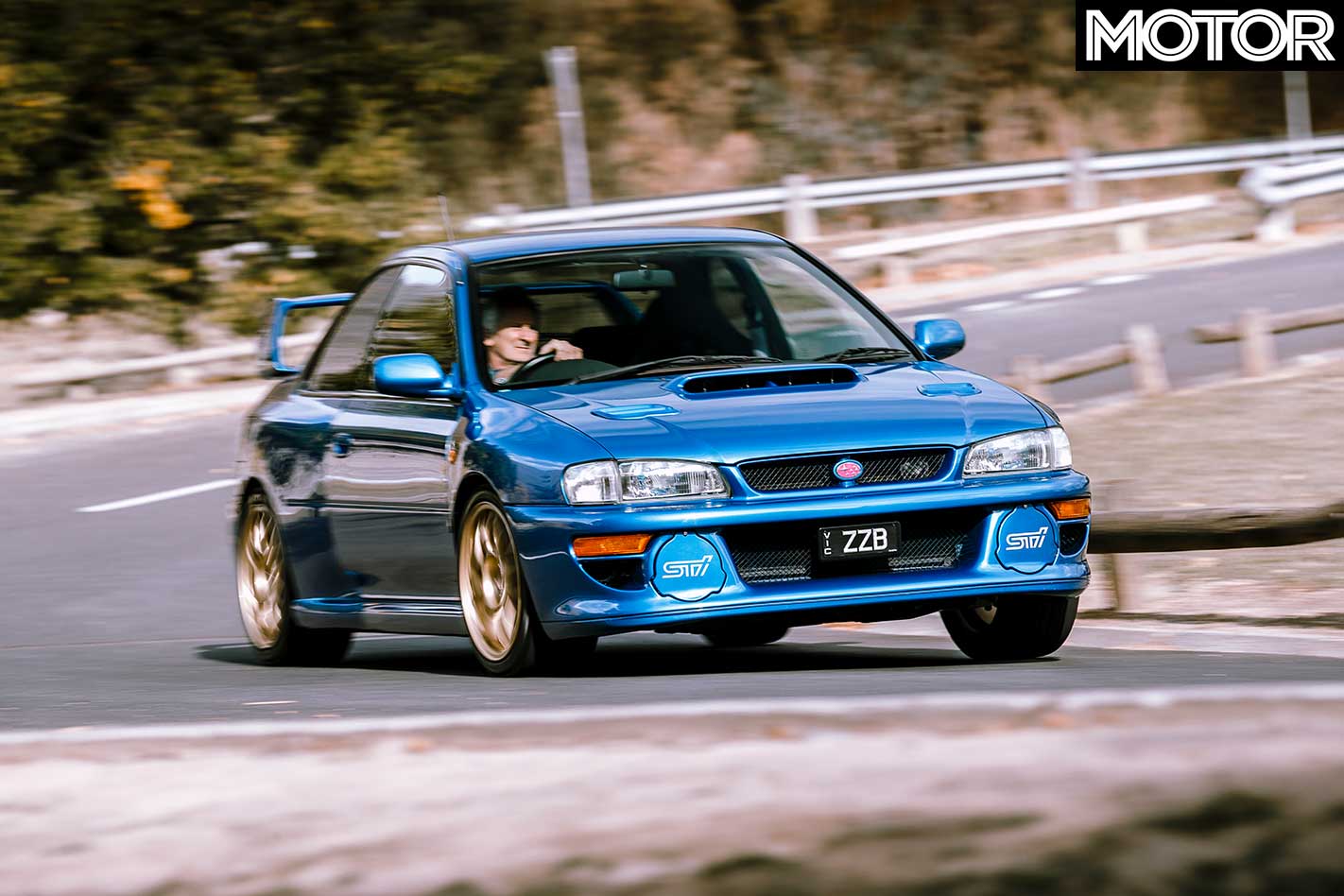
BODY: 2-door, 5-seat coupe DRIVE: all-wheel ENGINE: 2212cc flat-4, DOHC, 16v, turbo BORE/STROKE: 96.0mm x 75.0mm COMPRESSION: 8.0:1 POWER: 206kW @ 6500rpm TORQUE: 363Nm @ 3200rpm WEIGHT: 1270kg POWER-TO-WEIGHT: 162kW/tonne TRANSMISSION: 5-speed manual SUSPENSION: struts, coil springs, anti-roll bar (f); struts, coil springs, anti-roll bar (r) L/W/h: 4365/1770/1405mm WHEELBASE: 2520mm TRACKS: 1480/1500mm (f/r) STEERING: hydraulically-assisted rack-and-pinion BRAKES: 320mm ventilated discs (f); 266mm ventilated discs (r) WHEELS: 17.0 x 8.5-inch (f/r) TYRES: Yokohama; 235/40 ZR17 (f/r) PRICE: $132,000 (new)
Conclusion
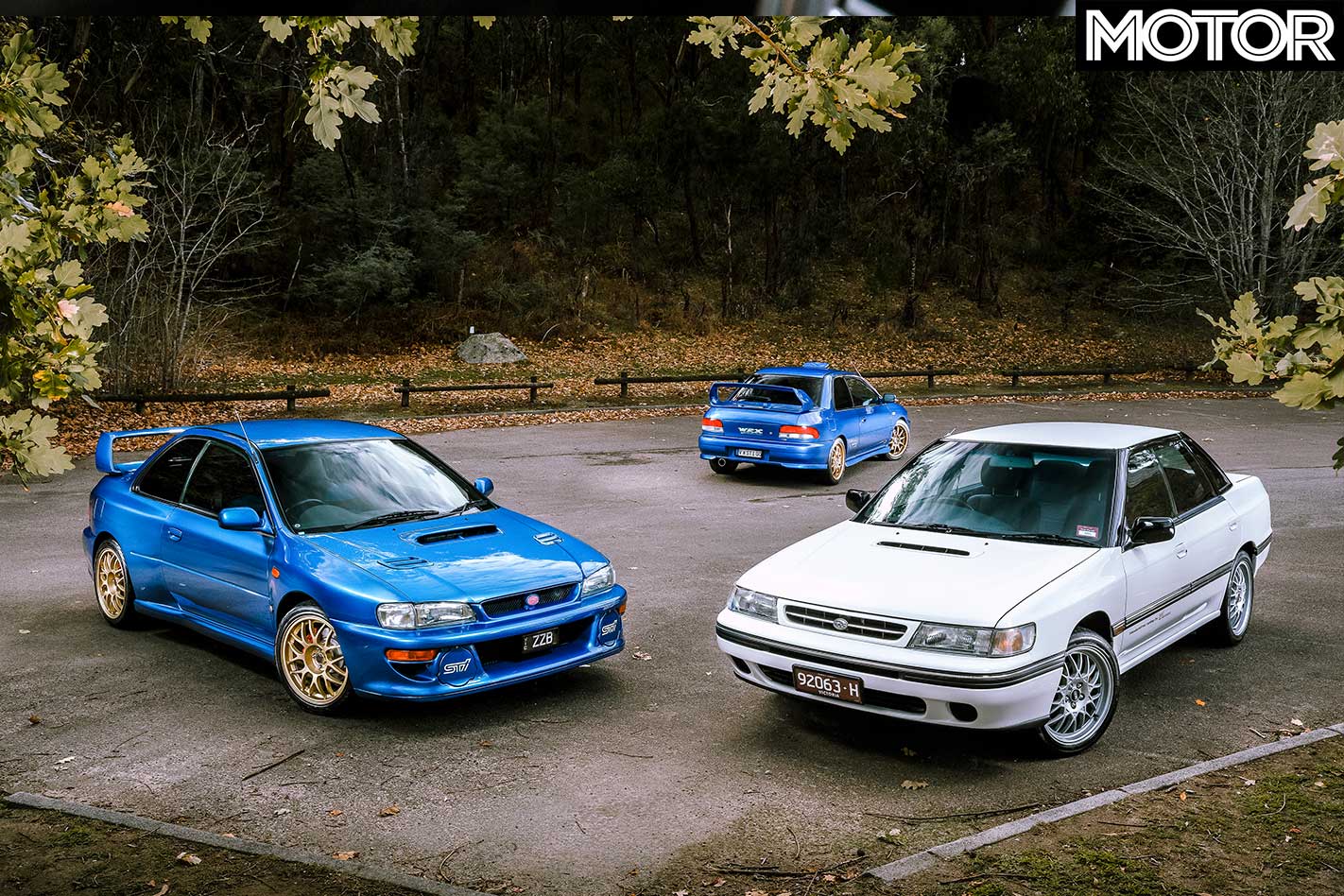
This is not a comparison test, no car wins. But after a day spent in throwback interiors with their distinctive hard plastics, thin A-pillars and a certain smell, one ponders the current situation of Subaru Tecnica International and perhaps the next 30 years for the brand.
It’s fair to say that STi’s best years are either behind it or ahead of it. The current WRX STi drives like it did 10 years ago while the turbocharged four-cylinder, all-wheel drive performance segment it helped popularise, is dominated by the Euros. And a car like the Ford Focus RS, itself having just entered retirement from old age, makes an STi feel very old school, analogue and antiquated indeed. A proper turbocharged STi BRZ, despite all the excuses for why it hasn’t happened, remains in our books a missed opportunity.
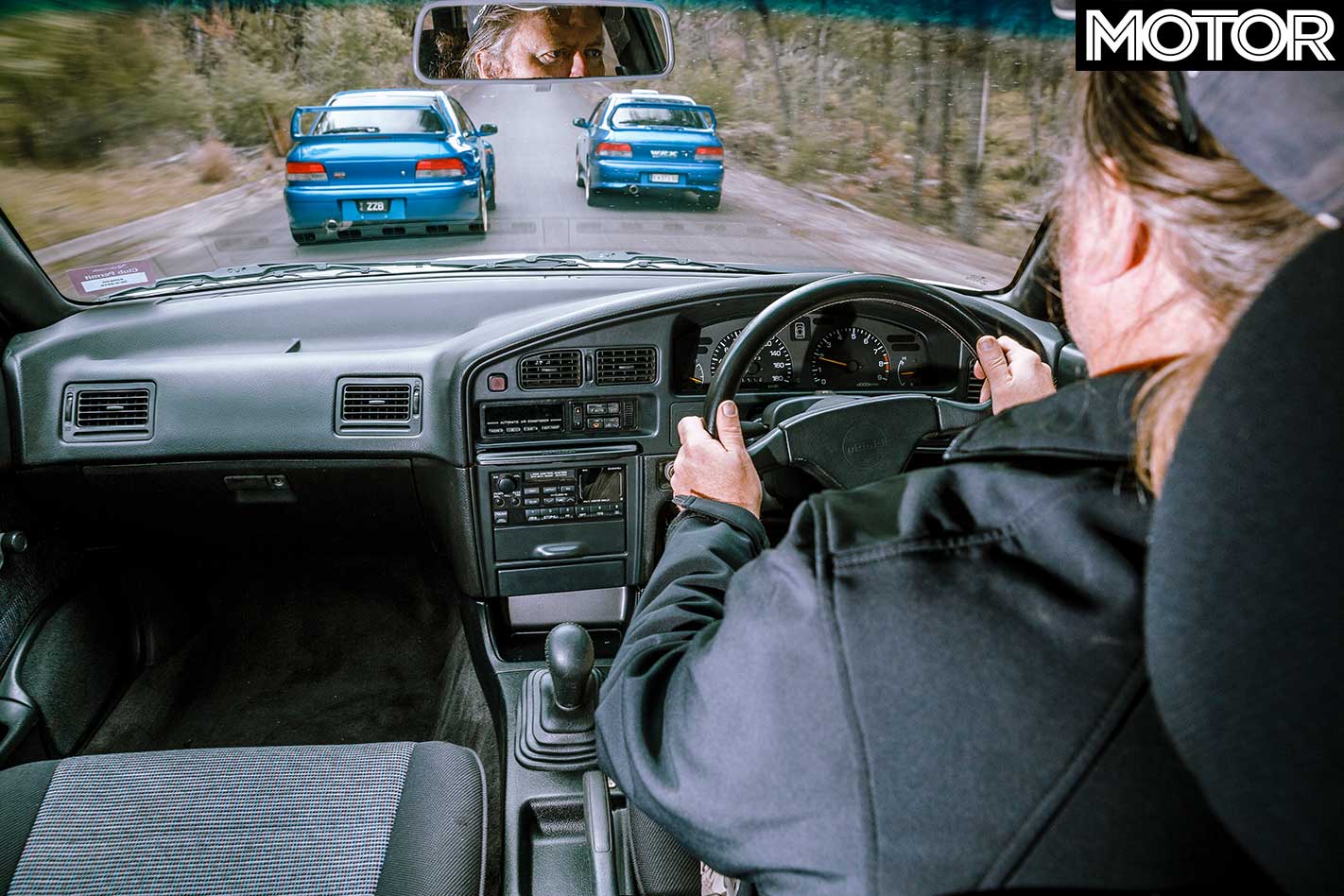
STi is still very active in motorsport, producing a popular production rally car but also in an official capacity in circuit racing like in Super GT and at the Nürburgring 24 Hour. Of course, it retains a factory presence in the Australian Rally Championship with Molly Taylor, who won the 2016 title in her production-spec rally car. But on the global stage, Subaru’s motorsport campaign continues in the long shadow of its World Rally Championship success.
While economic natural selection in a sluggish Japan killed the Mitsubishi Lancer Evolution, it appears STi is picking itself back up and readying to give smug Euros like the Mercedes-AMG A45, Audi RS3 and VW Golf R a very bloody nose indeed.
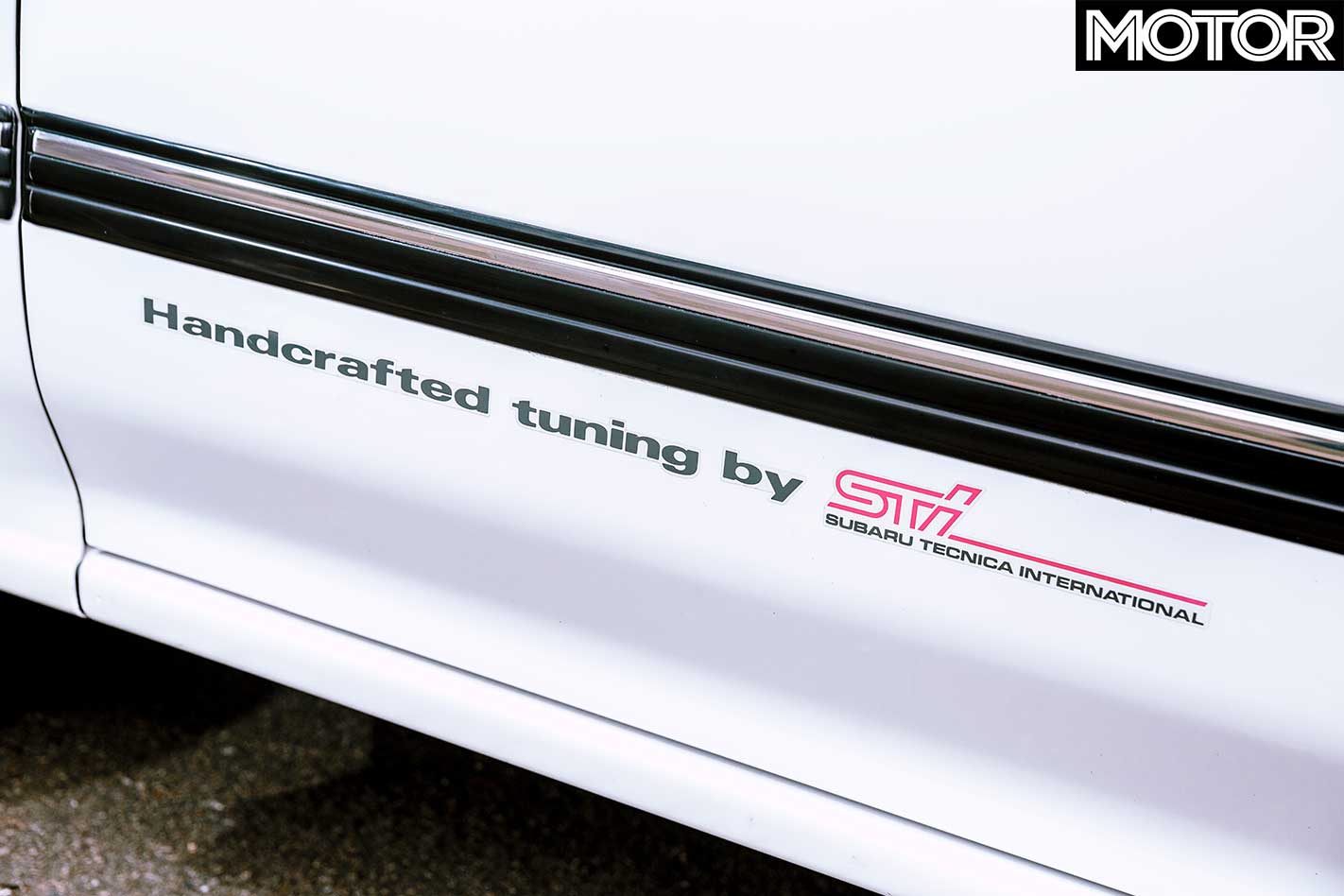
Subaru’s VIZIV Concept, unveiled at the 2017 Tokyo Motor Show, represents the beginning of probably a long teaser period for the next WRX STI, due around 2020. Details are scarce, but Subaru says it has all-wheel drive and a boxer engine – presumably four cylinders and turbocharged. Subaru has also said the WRX and STi cannot continue as petrol-only propositions, so on the basis of the VIZIV retaining a petrol engine, expect the next STi to sport a hybrid drivetrain.
Honda catapulted the Civic Type R to the top of the hot hatch pecking order in one go. Perhaps the Japanese engineers at STi can do the same with its next performance hero. Certainly, it has the runs on the board to suggest so.

